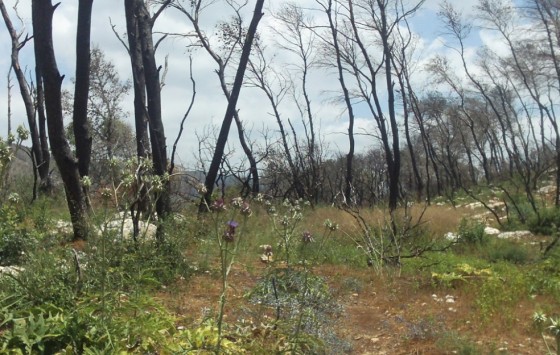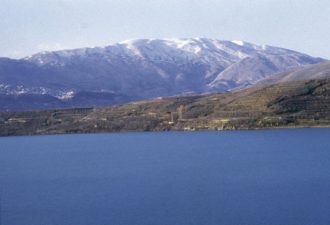 A year after the fire in Israel, Joshua finds new life at the ravaged Carmel Forest.
A year after the fire in Israel, Joshua finds new life at the ravaged Carmel Forest.
Israel experienced the largest wildfire in the country’s history nearly a year ago. The blaze broke out near Isifiya, in the Carmel region, on December 2, 2010. Spreading over large swaths of land overnight, the fire quickly consumed 5,000 hectares before emergency crews extinguished it. Firefighters were able to gain the upper hand only after four days. A large amount of fuel on the forest floor – dry material accumulated from a hot summer – hastened its progression.
It was a tragedy on both a geographic and human scale. Fourty-four people perished. When the smoke cleared, a shocked country was left grieving and devastated. After the funerals and memorials, Israelis considered their options.
The natural reaction for many was to begin replanting. The Zionist pioneers of Israel highly valued tree planting. This act fulfilled a very basic tenet of Judaism. Jews are obligated by the Torah to plant fruit trees to settle the land. Additionally, planting trees provides agriculture, shade, a haven for wildlife, and aesthetic value. So central are trees to Jewish life and philosophy that Jews refer to the Torah, their holiest book, as the “Tree of Life”.
But several ecologists warned that replanting too soon could be counterproductive as it may disturb nature’s own healing process. The Jewish National Fund and the Society for Protection of Nature in Israel managed to convince the government not to replant immediately after the fire. Their reasoning was that nature possesses far superior restorative abilities than man.
Researchers studying rehabilitation of the Sha’ar Ha-gai (just west of the Jerusalem Hills) Forest Fire in 1995 concluded that replanting is not necessarily successful in accelerating forest regeneration. The Sha’ar Ha-gai study showed that areas which were replanted did not grow faster than areas left alone.
Thus, the government agreed to wait one year before making any decisions about rehabilitating the Carmel. The advice of ecologists from the University of Haifa and elsewhere was very influential in the decision.
But as we approach the anniversary of the Carmel fire, there is mounting pressure on the government to begin a restoration campaign. The forest, once a lush haven for hikers and nature enthusiasts, has become an eyesore. Large swaths of blackened treetops can be seen from nearly every vantage point in the area.
The Israeli Cabinet authorized $15 million USD for the Carmel area this past summer, including an outlay for reforestation. JNF crews have been active in the area recently, thinning brush and removing burned trees to ease the struggle of seedlings. They have also surveyed the area to determine where to plant oak, cypress, pistachio, and pine trees. The Carmel has the only population of Aleppo pine trees on the eastern Mediterranean coast.
And a month ago, Cyprus presented the State of Israel with 300 trees as a gift for the Jewish New Year. After a ceremony honoring speedy Cyprian aid during the crisis, the attendees got to work planting the trees.
There is great momentum toward a full restoration effort. But the rush to restore could be a mistake. It could interfere with an important natural process. Experts remark on the forest’s adaptation to fire regimes, which have existed throughout the region’s history.
Professor Ido Izhaki, Director of the Carmel Research Center at the University of Haifa, says we need not interfere too much. “There are plant species [there] that have developed resilience to fire and those that have developed a dependency on fire, such as the Aleppo pine.”
The Aleppo pine cones actually require heat from fire to open. This process releases their seeds to the ground. “After this enormous fire, the Carmel will be covered with pine buds,” Izhaki says.
The once great Carmel Forest will return regardless of what we do. But its return should be heralded by nature, not by the desperate acts of men. What greater gesture of love for the forest than to leave it in peace?



